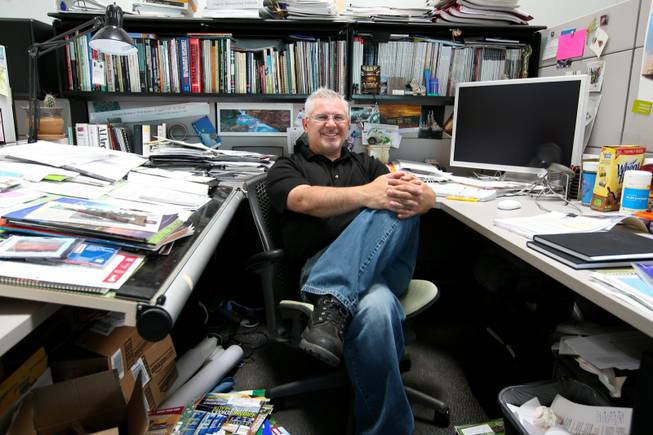
Jeff Roberts, a principal at Lucchesi Galati Architects, says green buildings are proving to be cost-effective, according to current data.
Friday, April 30, 2010 | 3 a.m.
Going green is paying dividends and is here to stay.
That’s long been the argument by advocates of sustainable buildings. Now they say they can prove their point, which should only bolster the industry.
“The green industry is moving ahead … the first data lines across the country are starting to show up in the buildings’ performance,” said Jeff Roberts, one of the principals of Las Vegas architecture firm Lucchesi Galati. “They are proving to be more cost-effective and better to operate and help maintain productivity in office and school settings.”
The green industry is in a similar place to what happened when the Americans With Disabilities Act was enacted in the early 1990s requiring buildings to be accessible to people with disabilities, Roberts said. Green building is starting to be an accepted practice, and it’s getting to the point where green features such as energy-efficiency systems are starting to become part of the code.
Green buildings can routinely produce energy and water savings of 10 percent to 25 percent compared with those that are not green, he said. For high-performance buildings that cost 5 percent to 10 percent more, the cost of the premium green features can be recovered in seven to 10 years through energy efficiencies, he said.
“The data points are proving that the green industry is not a passing fad as some people in the industry still believe it is,” Roberts said. “The cost is becoming better than it used to be because there are more products that you can find, such as carpet. You can do a basic green standard for no extra cost.”
That is important because there is always a battle that exists when green projects are designed, Roberts said. Some contractors will try and persuade the building owner that he could save money in construction costs by foregoing some green materials and features, he said.
“It all becomes economics and whether they can save money. That is one of the hurdles that we still fight every day,” Roberts said.
Lucchesi Galati was an advocate of sustainable building before it was trendy to do so, Roberts said.
The firm’s notable projects include the Las Vegas Springs Preserve master plan and Desert Living Center and Gardens. It designed two buildings at Springs Preserve that are made of straw and two made of rammed earth. The campus has solar hot-water heaters and treats water used on site.
No matter the project, whether it’s a new gym for the high school portion of Meadows School for a community center, there is an emphasis on green, Roberts said. That means allowing in more natural daylight, using less water and using materials in construction that don’t have any volatile organic compounds.
But Roberts said the industry is starting to move beyond that point and take itself to the next level.
“I think for us we are saying that the boundaries of the word ‘sustainability’ is not good enough any more,” Roberts said. “That just means we are maintaining where we are at, but I think we need to push green environmental design and look at restorative and regenerative.”
That means creating habitat for wildlife and designing facilities that use no water and create their own power, Roberts said.
In the past, a lot of projects graded land and put in pipes for a drainage system akin with a U.S. Corps of Engineers concept, Roberts said. The solution to storm water was capturing it and flushing it downstream for someone else to deal with, he said.
Today, the emphasis is on capturing that storm water and keeping it on the property in a pond that becomes a habitat for wildlife, Roberts said.
The firm has designed a visitor center for the U.S. Fish and Wildlife Service 45 miles north of Las Vegas between Kyle and Lee canyons. It is working with the Santa Monica Mountains Conservancy for a visitor’s center in Calabasas, Calif., winning over 80 other bidders. It is also doing work for the Lied Discovery Children’s Museum.
“In our industry, so much of the work has been shipped overseas where it is done cheaper, that we are more consultant based and sharing intellectual knowledge, especially in sustainable design,” Roberts said.
The lack of construction in Las Vegas has been tough on architecture firms and architects in general, but Lucchesi Galati has been able to maintain its staff of 25 people by focusing more of its work out of state, including California, Roberts said.
“We have positioned ourselves to do federal work because you can’t rely on (just working in) Las Vegas,” Roberts said.
The firm has even started to do green audits to evaluate where businesses could save on their water and energy usage.
That will be a greater emphasis in the future when building are renovated, he said. But it’s probably less of an option in Las Vegas, where many buildings are newer than in other parts of the Southwest, he said.


Join the Discussion:
Check this out for a full explanation of our conversion to the LiveFyre commenting system and instructions on how to sign up for an account.
Full comments policy